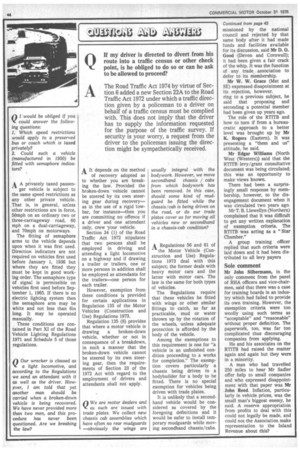Q Our wrecker is classed as a light locomotive, and according
Page 46

If you've noticed an error in this article please click here to report it so we can fix it.
to the Regulations we send an attendant with it as well as the driver. However, I am told that yet another man should be carried when a broken-down vehicle is being recovered. We have never provided more than two men, and this procedure has never been questioned. Are we breaking the law? A It depends on the method of recovery adopted as to whether you are breaking the law. Provided the broken-down vehicle cannot be steered by its own steering gear during recovery— as in the use of a rigid towbar, for instance—then you are committing no offence if a driver and one attendant only, crew 'your vehicle.
Section 34 (1) of the Road Traffic Act 1972 stipulates that two persons shall be employed in driving and attending a light locomotive on a highway and if drawing a trailer or trailers, one or more persons in addition shall be employed as attendants for the trailers—one person for each trailer.
However, exemption from these conditions is provided for certain applications in Regulation 135 of the Motor Vehicles (Construction and Use) Regulations 1973.
Regulation 135 (8) provides that where a motor vehicle is drawing a broken-down vehicle, whether or not in consequence of a breakdown, in such a manner that the broken-down vehicle cannot be steered by its own steering gear, then the requirements of Section 23 of the 1972 Act with regard to the employment of drivers and attendants shall not apply.
































































































